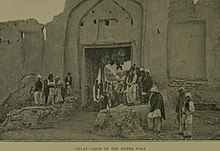
The Third Anglo-Afghan War was a short war which began on 3 May and ended on 8 August 1919. The new Amir of the Emirate of Afghanistan Amanullah Khan declared a Jihad against the British in the hope to proclaim full independence, as well as to strengthen his own legitimacy. Amanullah's forces invaded British India on three fronts taking advantage of the unrest in India, in an effort to seize the old Afghan provinces west of the River Indus.
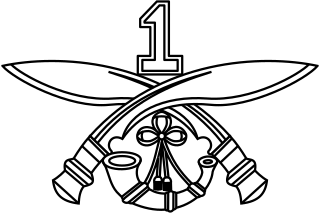
1st Gorkha Rifles (The Malaun Regiment), often referred to as the 1st Gorkha Rifles, or 1 GR in abbreviation, is the most senior Gorkha Infantry regiment of the Indian Army, comprising Gurkha soldiers of Indian Gorkha or Nepalese nationality, especially Magars and Gurungs, hill tribes of Nepal. It was originally formed as part of the East India Company's Bengal Army in 1815, later adopting the title of the 1st King George V's Own Gurkha Rifles (The Malaun Regiment), however, in 1947, following the partition of India, it was transferred to the Indian Army and in 1950 when India became a Republic, it was redesignated as 1st Gorkha Rifles (The Malaun Regiment). The regiment has a long history and has participated in many conflicts, including many of the colonial conflicts prior to Indian independence, as well as the First and Second World Wars. Since 1947 the regiment has also participated in a number of campaigns against Pakistan in 1965 and 1971 as well as undertaking peacekeeping duties as part of the United Nations.

The North-West Frontier was a region of the British Indian Empire. It remains the western frontier of present-day Pakistan, extending from the Pamir Knot in the north to the Koh-i-Malik Siah in the west, and separating the modern Pakistani frontier regions of North-West Frontier Province, Federally Administered Tribal Areas and Balochistan from neighbouring Afghanistan in the west. The borderline between is officially known as the Durand Line and divides Pashtun inhabitants of these provinces from Pashtuns in eastern Afghanistan.
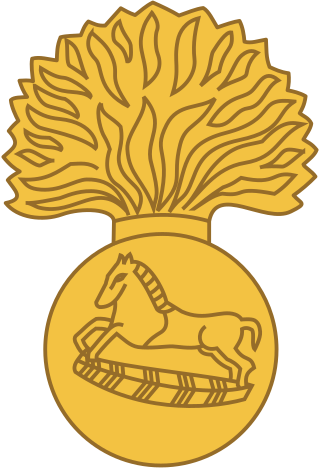
The Grenadiers is an infantry regiment of the Indian Army, formerly part of the Bombay Army and later the pre-independence British Indian Army, when the regiment was known as the 4th Bombay Grenadiers. It has distinguished itself during the two world wars and also since the Independence of India. The regiment has won many battle honours and gallantry awards, and is considered to be one of India's most decorated regiments with three Param Vir Chakra awardees in three different conflicts.
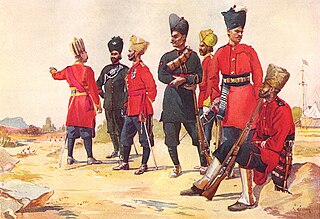
The 123rd Outram's Rifles was an infantry regiment of the British Indian Army.
The Central India Campaign was one of the last series of actions in the Indian rebellion of 1857. The British Army and Bombay Army overcame a disunited collection of states in a single rapid campaign, although determined rebels continued a guerrilla campaign until the spring of 1859.

The 2nd Queen Victoria's Own Rajput Light Infantry, commonly shortened to 2nd Rajputs, was a regiment of the British Indian Army. Raised in 1798, it was amalgamated with five other Rajput regiments in 1922.

The Anglo-Persian War, also known as the Anglo-Iranian War, was a war fought between the United Kingdom and Iran, which was ruled by the Qajar dynasty. The war had the British oppose an attempt by Iran to press its claim on the city of Herat. Though Herat had been part of Iran under the Qajar dynasty when the war broke out, it had declared itself independent under its own rebellious emir and placed itself under the protection of the British in India and in alliance with the Emirate of Kabul, the predecessor of the modern state of Afghanistan. The British campaign was successfully conducted under the leadership of Major General Sir James Outram in two theatres: on the southern coast of Persia near Bushehr and in southern Mesopotamia.

The Battle of Ghazni took place in the city of Ghazni in central Afghanistan on Tuesday, July 23, 1839, during the First Anglo-Afghan War.

The 4th Cavalry was a cavalry regiment of Awadh (1838-40), the Bengal Army (1838-1895) and the British Indian Army (1895-1922).
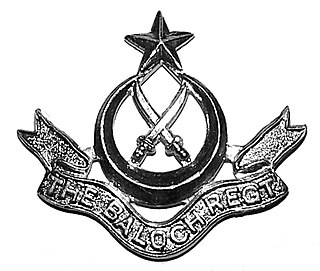
The Baloch Regiment is an infantry regiment of the Pakistan Army. The modern regiment was formed in May 1956 by the merger of 8th Punjab and Bahawalpur Regiments with the Baluch Regiment. Since then, further raisings have brought the strength of the Regiment to 27 battalions. The Baloch Regiment is descended from the infantry of the old British Indian Army and is named after Balochistan. Before 1991, it was called the Baluch Regiment but the spelling was changed to 'Baloch' to better reflect the correct pronunciation.

The 129th Duke of Connaught's Own Baluchis was an infantry regiment of the British Indian Army raised in 1846 as the 2nd Bellochee Battalion. It was designated as the 129th Duke of Connaught's Own Baluchis in 1903, and became 4th Battalion 10th Baluch Regiment in 1922. In 1947, it was allocated to Pakistan Army, where it continues to exist as 11th Battalion of The Baloch Regiment.

The presidency armies were the armies of the three presidencies of the East India Company's rule in India, later the forces of the British Crown in India, composed primarily of Indian sepoys. The presidency armies were named after the presidencies: the Bengal Army, the Madras Army and the Bombay Army. Initially, only Europeans served as commissioned or non-commissioned officers. In time, Indian Army units were garrisoned from Peshawar in the north, to Sind in the west, and to Rangoon in the east. The army was engaged in the wars to extend British control in India and beyond.

The 10th Baluch or Baluch Regiment was a regiment of the British Indian Army from 1922 to 1947. After independence, it was transferred to the Pakistan Army. In 1956, it was amalgamated with the 8th Punjab and Bahawalpur Regiments. During more than a hundred years of military service, the 10th Baluch Regiment acquired a distinguished record amongst the regiments of the British Indian Army. Its list of honours and awards includes four Victoria Crosses.

The 106th Hazara Pioneers was a pioneer infantry regiment of the British Indian Army. They were formed in 1904 at Quetta from Hazara people. They were disbanded in 1933.
The 4th Prince Albert Victor's Rajputs was an infantry battalion of the British Indian Army. They could trace their origins to 1798, when they were the 2nd Battalion, 16th Bengal Native Infantry. Over the years they became known by a number of different titles. The 33rd Bengal Native Infantry 1824–1861, the 4th Bengal Regiment of Bengal Native Infantry 1861–1890, the 4th Bengal Infantry 1890–1897, the 4th Rajput Regiment 1897–1901 and finally after the Kitchener reforms of the Indian Army the 4th Rajputs. To honour the visit of the Prince and Princess of Wales to India they took part in the Rawalpindi Parade 1905. They took part in the First Anglo-Sikh War, the Second Anglo-Afghan War, the Third Anglo-Burmese War and World War I. After World War I the Indian government reformed the army again moving from single battalion regiments to large multi battalion regiments, the 4th Prince Albert Victor's Rajputs became the 2nd Battalion, 7th Rajput Regiment. After India gained independence they were one of the regiments allocated to the Indian Army.

The 130th King George's Own Baluchis (Jacob's Rifles) was an infantry regiment of the British Indian Army raised in June 1858 as the 1st Belooch Rifles; re-designated as 1st Regiment Jacob's Rifles in September. It was designated as 130th Jacob's Baluchis in 1903 becoming 5th Battalion (King George's Own) 10th Baluch Regiment (Jacob's Rifles) in 1922. In 1947, it was allotted to Pakistan Army, where it continues to exist as 12th Battalion of The Baloch Regiment.

The 124th Duchess of Connaught's Own Baluchistan Infantry was an infantry regiment of the British Indian Army raised in 1820 as the 2nd (Marine) Battalion 12th Regiment of Bombay Native Infantry. It was designated as the 124th Duchess of Connaught's Own Baluchistan Infantry in 1903 and became 1st Battalion 10th Baluch Regiment in 1922. In 1947, it was allocated to Pakistan Army, where it continues to exist as 6th Battalion of The Baloch Regiment.

Brigadier John Pennycuick CB, KH was an officer in the British Army who served in Java, Burma, Aden, Afghanistan and India. He was born in Soilzarie in Perthshire and was killed at the Battle of Chillianwalla in the Second Anglo-Sikh War.
The 57th Indian Brigade was an infantry brigade of the British Indian Army that was active in the Indian Army during the First World War and took part in the Third Anglo-Afghan War in 1919. It was not reformed for the Second World War.
